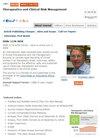影响成人患者在内镜下处理尖锐食管异物后禁食时间的因素
IF 2.8
3区 医学
Q1 Pharmacology, Toxicology and Pharmaceutics
引用次数: 0
摘要
背景:尖锐食管异物(SEFB)嵌顿会对食管造成不同程度的损伤。分析 SEFB 患者术后禁食时间的研究很少:我们回顾性地收集了 835 例 SEFB 患者。方法:我们回顾性收集了 835 例 SEFB 患者,根据内镜下切除 SEFB(ER)后的禁食时间将患者分为两组:禁食时间短(SFT,禁食 ≤ 24 小时)和禁食时间长(LFT,禁食 > 24 小时):结果:短空腹时间组和长空腹时间组分别有 216 名和 619 名患者。SFT 组的平均年龄(52.97 岁)比 LFT 组(55.96 岁)年轻(P = 0.025)。与 SFT 组相比,LFT 组异物嵌顿时间(DOI)在 12 小时内的比例(14.2% vs 22.2%,p = 0.006)和侵蚀率(89.0% vs 94.0%,p = 0.034)较低,食管穿孔比例(19.5 vs 6.5%,p = 0.010)和接受静脉麻醉的患者比例(63.78% vs 31.9%,p = 0.000)较高。LFT 组异物的最长直径(Lmax)(2.60 ± 1.01 厘米)大于 SFT 组(2.41 ± 0.83 厘米;P = 0.01)。多变量回归分析发现,年龄(OR = 1.726[1.208- 2.465],p = 0.003)、DOI(OR = 1.793[1.175- 2.737],p = 0.007)、Lmax(OR = 1.477[1.033- 2.111],p = 0.032)、穿孔(OR = 3.698[2.038- 6.710];p <;0.01)和静脉麻醉(OR = 3.734[2.642- 5.278]; p <0.01)是延长SEFBs患者禁食时间的独立因素,而食管黏膜糜烂(OR = 0.433[0.229- 0.820]; p = 0.01)是导致禁食时间缩短的影响因素:我们首次分析了影响 SEFB 患者 ER 后禁食时间的因素。年龄、DOI、Lmax、穿孔和静脉麻醉是导致术后禁食时间延长的风险因素。本文章由计算机程序翻译,如有差异,请以英文原文为准。
Factors Influencing the Fasting Time in Adult Patients After the Endoscopic Management of Sharp Esophageal Foreign Bodies
Background: Sharp esophageal foreign body (SEFB) impaction can cause varying degrees of damage to the esophagus. There are few studies analyzing the postoperative fasting time in SEFB patients.
Methods: We retrospectively collected 835 SEFB patients. According to the fasting time after the endoscopic removal (ER) of SEFBs, the patients were divided into two groups: short fasting time (SFT, fasted ≤ 24 h) and long fasting time (LFT, fasted > 24 h).
Results: There were 216 and 619 patients in the SFT and LFT group, respectively. The average age of the SFT group (52.97 years) was younger than that of the LFT group (55.96 years) (p = 0.025). The LFT group had lower proportion of duration of impaction (DOI) within 12 hours (14.2% vs 22.2%, p = 0.006) and erosion rates (89.0% vs 94.0%, p = 0.034) as well as higher proportion of esophageal perforation (19.5 vs 6.5%, p = 0.010) and patients who got intravenous anesthesia (63.78% vs 31.9%, p = 0.000) than the SFT group. The longest diameter of the foreign body (Lmax) in the LFT group (2.60 ± 1.01 cm) was greater than that in the SFT group (2.41 ± 0.83 cm; p = 0.01). Multivariate regression analysis found that age (OR = 1.726[1.208– 2.465], p = 0.003), DOI (OR = 1.793[1.175– 2.737], p = 0.007), Lmax (OR = 1.477[1.033– 2.111], p = 0.032), perforation (OR = 3.698[2.038– 6.710]; p < 0.01) and intravenous anesthesia (OR = 3.734[2.642– 5.278]; p < 0.01) were the independent factors that prolonged fasting time in patients with SEFBs, while esophageal mucosal erosion (OR = 0.433[0.229– 0.820]; p = 0.01) was the influencing factor leading to shortened fasting time.
Conclusion: For the first time, we analyzed factors influencing the fasting time after ER in SEFB patients. Age, DOI, Lmax, perforation and intravenous anesthesia were risk factors for a prolonged postoperative fasting time.
Methods: We retrospectively collected 835 SEFB patients. According to the fasting time after the endoscopic removal (ER) of SEFBs, the patients were divided into two groups: short fasting time (SFT, fasted ≤ 24 h) and long fasting time (LFT, fasted > 24 h).
Results: There were 216 and 619 patients in the SFT and LFT group, respectively. The average age of the SFT group (52.97 years) was younger than that of the LFT group (55.96 years) (p = 0.025). The LFT group had lower proportion of duration of impaction (DOI) within 12 hours (14.2% vs 22.2%, p = 0.006) and erosion rates (89.0% vs 94.0%, p = 0.034) as well as higher proportion of esophageal perforation (19.5 vs 6.5%, p = 0.010) and patients who got intravenous anesthesia (63.78% vs 31.9%, p = 0.000) than the SFT group. The longest diameter of the foreign body (Lmax) in the LFT group (2.60 ± 1.01 cm) was greater than that in the SFT group (2.41 ± 0.83 cm; p = 0.01). Multivariate regression analysis found that age (OR = 1.726[1.208– 2.465], p = 0.003), DOI (OR = 1.793[1.175– 2.737], p = 0.007), Lmax (OR = 1.477[1.033– 2.111], p = 0.032), perforation (OR = 3.698[2.038– 6.710]; p < 0.01) and intravenous anesthesia (OR = 3.734[2.642– 5.278]; p < 0.01) were the independent factors that prolonged fasting time in patients with SEFBs, while esophageal mucosal erosion (OR = 0.433[0.229– 0.820]; p = 0.01) was the influencing factor leading to shortened fasting time.
Conclusion: For the first time, we analyzed factors influencing the fasting time after ER in SEFB patients. Age, DOI, Lmax, perforation and intravenous anesthesia were risk factors for a prolonged postoperative fasting time.
求助全文
通过发布文献求助,成功后即可免费获取论文全文。
去求助
来源期刊

Therapeutics and Clinical Risk Management
HEALTH CARE SCIENCES & SERVICES-
CiteScore
5.30
自引率
3.60%
发文量
139
审稿时长
16 weeks
期刊介绍:
Therapeutics and Clinical Risk Management is an international, peer-reviewed journal of clinical therapeutics and risk management, focusing on concise rapid reporting of clinical studies in all therapeutic areas, outcomes, safety, and programs for the effective, safe, and sustained use of medicines, therapeutic and surgical interventions in all clinical areas.
The journal welcomes submissions covering original research, clinical and epidemiological studies, reviews, guidelines, expert opinion and commentary. The journal will consider case reports but only if they make a valuable and original contribution to the literature.
As of 18th March 2019, Therapeutics and Clinical Risk Management will no longer consider meta-analyses for publication.
The journal does not accept study protocols, animal-based or cell line-based studies.
 求助内容:
求助内容: 应助结果提醒方式:
应助结果提醒方式:


